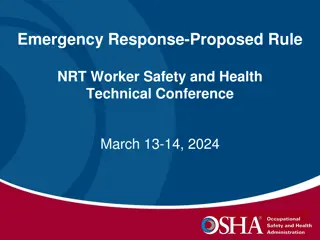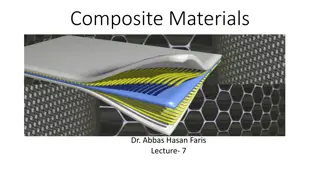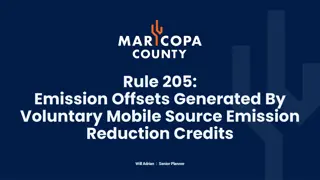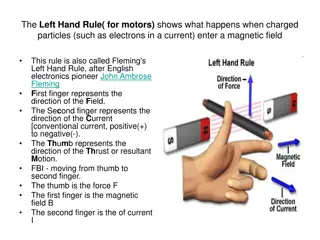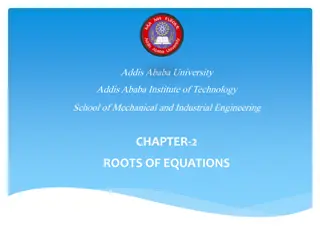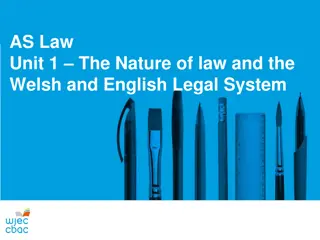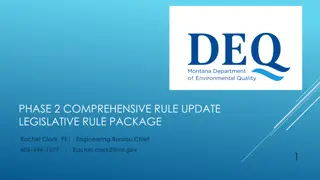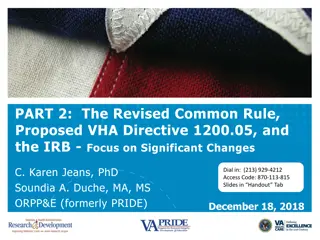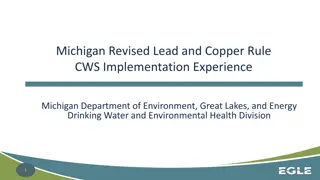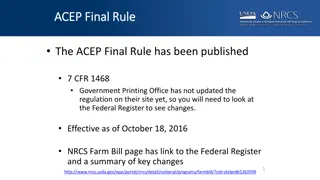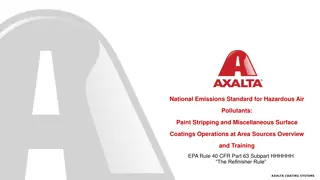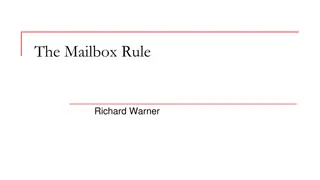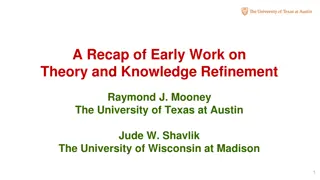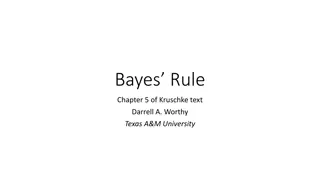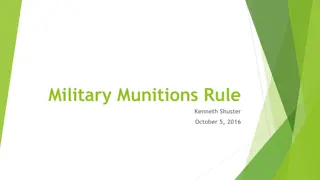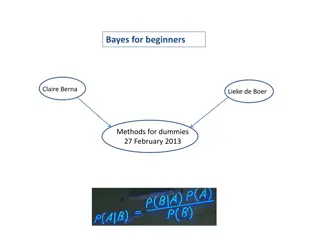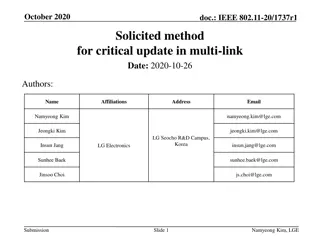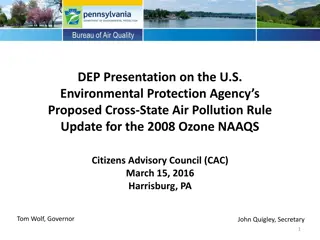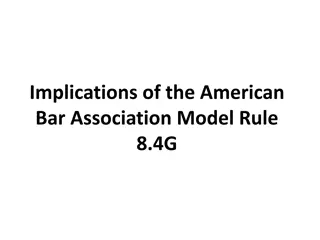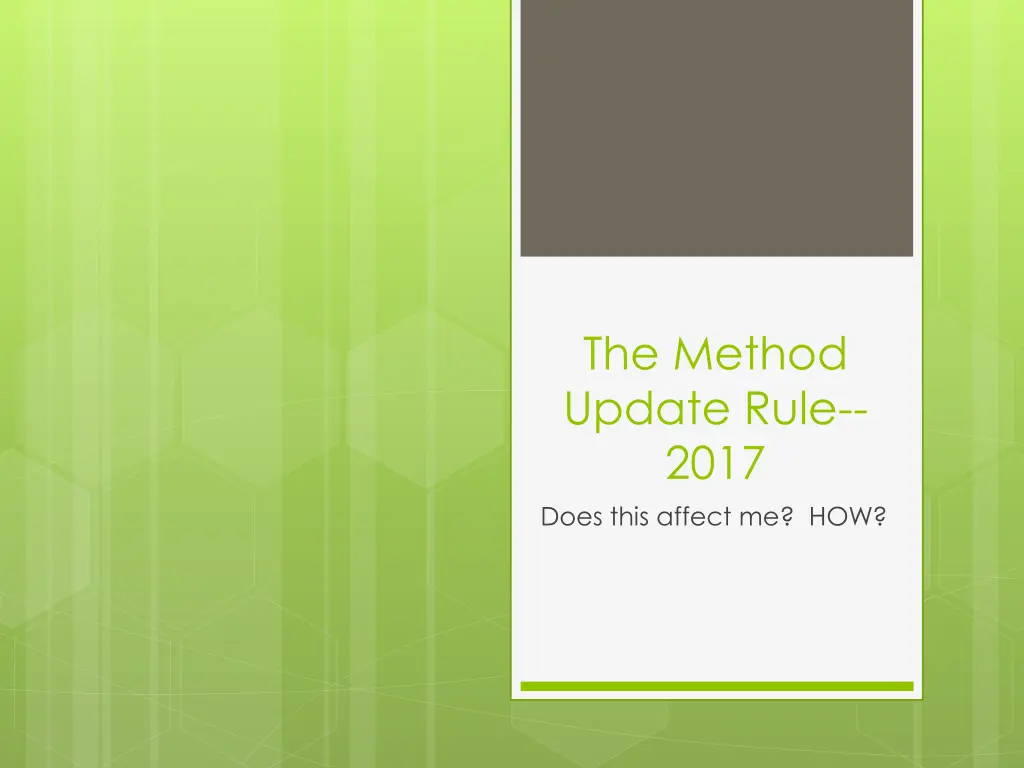
Impact of Updated Environmental Testing Methods
Explore the latest changes in environmental testing methods for quality control, including updates to standard methods, micro methods, EPA methods, VOA and SVOA organics, and ASTM and USGS methods. Stay informed on modifications affecting water quality assessments, microbiological counting rules, and more.
Download Presentation

Please find below an Image/Link to download the presentation.
The content on the website is provided AS IS for your information and personal use only. It may not be sold, licensed, or shared on other websites without obtaining consent from the author. If you encounter any issues during the download, it is possible that the publisher has removed the file from their server.
You are allowed to download the files provided on this website for personal or commercial use, subject to the condition that they are used lawfully. All files are the property of their respective owners.
The content on the website is provided AS IS for your information and personal use only. It may not be sold, licensed, or shared on other websites without obtaining consent from the author.
E N D
Presentation Transcript
The Method Update Rule-- 2017 Does this affect me? HOW?
Method Updates Standard Methods updated to reflect those published in the 22ndEdition Method number with the year of publication The method for BOD/CBOD is SM 5210 B-2011
Standard Methods Updated methods refer to quality control sections 1020 Chemical and Radiochemical analyses 2020 2000 Methods (Turbidity, Acidity, Hardness, Solids, etc.) 3020 3000 (Metals) and 4000 (Inorganic Nonmetallic Methods 9020 Microbiology
Micro Methods Some changes to SM 9222B (Standard Total Coliforms) Allows use of humidified incubator Added a note in Procedure section 4.5f that at least 5 typical and atypical colonies must be verified per membrane The calculation of coliform density (Section 5b Water of other than drinking water quality ) has been modified to be more like the EPA Microbiological counting rules
Micro Methods... SM 9222D-2006 Thermotolerant (Fecal) coliform Membrane Filter Procedure Footnote 30 was added to Table IA, requiring on a monthly basis, at least ten blue colonies from the medium must be verified using Lauryl Tryptose Broth and EC both
Updated EPA Methods Pesticides and PCBs: 608 is now 608.3 Includes additional analytes Allows for alternate detector; Requires confirmation of identification Added reporting limits Allows for SPE Allows for method modifications
VOA and SVOA Organics Volatiles--624 is now 624.1 Expanded scope to include additional analytes Allows for method modifications Allows for flexibility Semivolatiles 625 is now 625.1 Changes are very similar to those in 624.1
ASTM and USGS Methods Approval of new versions of currently approved ASTM Methods New USGS Methods for the Colorimetric Determination of Nitrate Plus Nitrite in Water by Enzymatic Reduction, Automated Discrete Analyzer Method
Approved ATPs IDEXX Laboratories, Inc., Colilert 18 for Fecal Coliforms in Wastewater addition of increased incubation temperature for fecal coliforms, which requires the use of a water bath HACH 10242: Simplified Spectrophotometric Measurement of TKN in Water and Wastewater HACH 10206: Spectrophotometric Measurement of Nitrate in Water and Wastewater Remember IDOPs!
Corrections made to the 40CFR Typographical errors, technology updates, etc. Whole Effluent Toxicity Acute and Chronic Methods Manuals clarifications in the definition of terms, consistency corrections among all three manuals. Table II, Required Containers, Preservation Techniques, and Holding Times Sodium thiosulfate concentrations for bacterial tests have been changed from 0.0008% to 0.008% sodium thiosulfate
Corrections/Clarifications Alternative Test Procedures Section: error in 2012 Method Update Rule appeared to give State permitting authorities the authority to approve ATPs for limited use. This was never the intent Only the Regional ATP Coordinator can approve the limited use of ATPs
Why a New MDL Determination Procedure? Addresses problems with the current procedure Blank contamination Long-term variance Actual detectability Reduces false positives due to background contamination An option to have MDLs that represent multiple instruments
MDL Determination Basics remain the same: MDL the lowest result that reliably indicates the analyte is in the sample Calculation is unchanged The entire analytical process is incorporated extraction, digestion
How is it different? Definition has changed slightly... OLD-- 99% confidence that the analyte concentration is greater than zero... NEW 99% confidence that the measured concentration is distinguishable from method blank results...
Inclusion of Method Blanks Low Level Spikes AND method blanks are analyzed over multiple days (at least 3) and multiple instruments An MDL calculated using the mean and standard deviation of MB results is compared with the MDL calculated from spiked samples The greater MDL is used as the Reported MDL
Initial Determination of MDL Blanks: Analyze at least 7 method blanks over a minimum of 3 days. Existing data is preferred; Calculate the MDLB using the formula: MDLB = mean +(SD)(Student s t value) MB results must be numerical; may be POSITIVE or NEGATIVE Use Zero for the mean if it is negative If all MB results are Non-detect (no peak on a chromatogram) the MDLBdoes not apply
Spiked Samples... Prepared and analyzed over at least 3 calendar days Calculate the MDLSas per usual: MDLS = SD(Student s t value)
Compare results The reported MDL will be the greater value MDLBor MDLS
Ongoing Data Collection Only use data associated with valid calibrations and batch QC Analyze at least two spikes (in separate batches) on each instrument per quarter for a total of at least 7 per year. Spike at the same concentration as the initial MDL spikes IF > 5% of the spikes are not positive numerical results that meet method identification criteria, increase spiking level and re-determine initial MDL
Collection of MB Data Analyze at least 7 blanks per year Use routine MB that are part of batch QC from the last 24 months If the number of MB>100, may use the 50 most recent results or those generated within the most recent 6 months whichever is greater
Annual Verification of MDL Every 13 months using the collected data from the past 24 months MB from the past 24 months Spiked samples at the same concentration as initial MDL spikes Include the initial MDL spikes if generated during the 24 month time frame
Re-calculate the MDLB& MDLS The verified MDL is the greater of the two values If the verified MDL is within 0.5 to 2.0 times the existing MDL, and fewer than 3% of the MB results have numerical results above the existing MDL, then the existing MDL may optionally be left unchanged. Otherwise, adjust the MDL to the new, verification MDL
MDL Procedure Implementation Issues Different process, new mind-set! Remembering to analyze quarterly spikes Keeping up with the data Possibly hundreds of method blank results to consider Multi-analyte tests such as volatiles, semivolatiles a bit cumbersome Learn the calculation rules
When will the MUR be approved? The MUR goes into effect 30 days after publishing date in Federal Register No estimated publication date!
How long will I have to implement the changes? Begin addressing the changes immediately New methods such as 624.1, 625.1, and 608.3 take time to learn and implement To implement MDL guidelines will not be instantaneous
The MUR of ???? Approval of updated methods Some old methods are going away 608, 624, 625 608.1, 624.1, 625.1 Approval of ATP methods: IDEXX for fecal; HACH 10242 for TKN; HACH 10206 for Nitrate Need to perform an IDOC for any new methods The new procedure for MDL determination
Questions? semberskip@adeq.state.ar.us For your attention!

